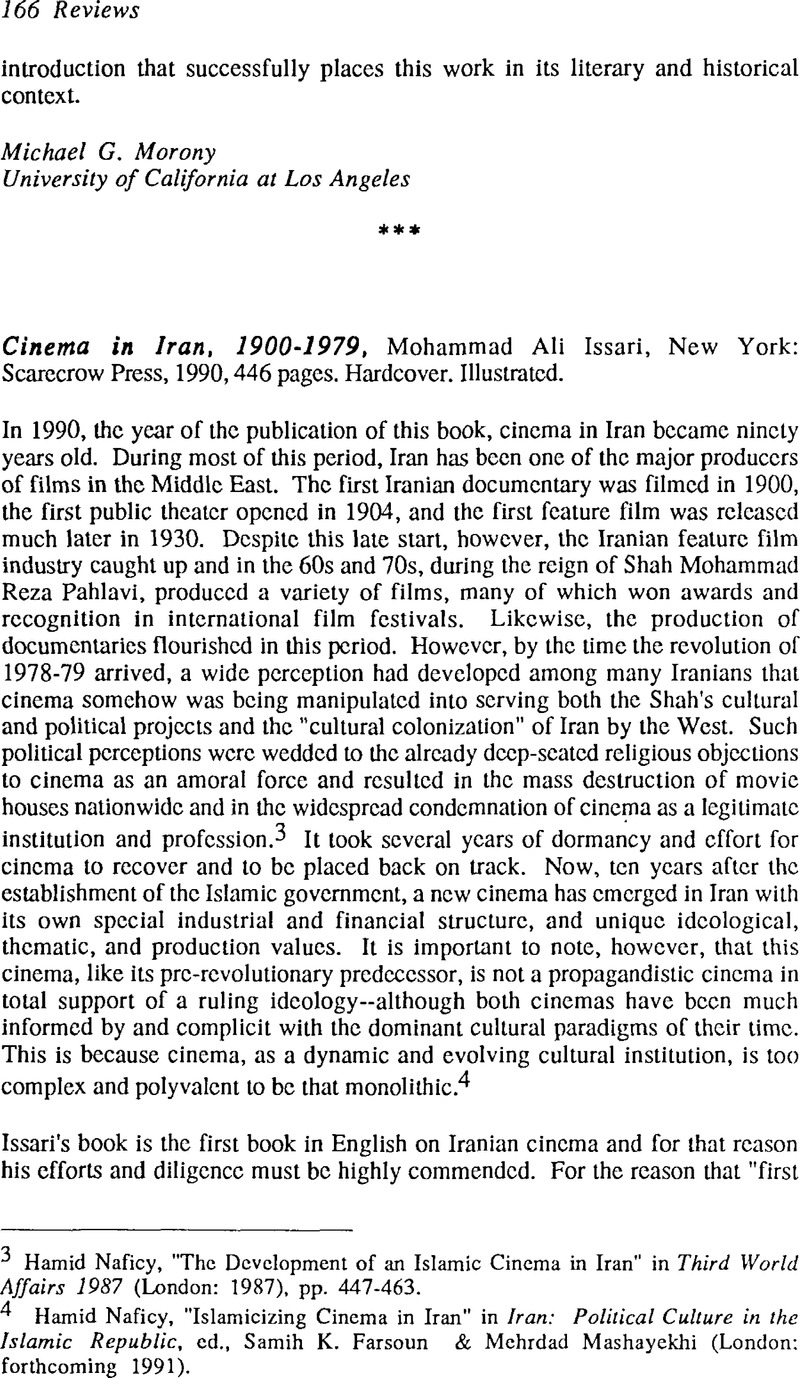No CrossRef data available.
Article contents
Cinema in Iran, 1900–1979, Mohammad Ali Issari, New York: Scarecrow Press, 1990, 446 pages. Hardcover. Illustrated.
Review products
Published online by Cambridge University Press: 01 January 2022
Abstract

- Type
- Reviews
- Information
- Copyright
- Copyright © Association For Iranian Studies, Inc 1989
References
3 Naficy, Hamid, “The Development of an Islamic Cinema in Iran” in Third World Affairs 1987 (London: 1987), pp. 447–463Google Scholar.
4 Naficy, Hamid, “Islamicizing Cinema in Iran” in Iran: Political Culture in the Islamic Republic, ed., Farsoun, Samih K. & Mashayekhi, Mehrdad (London: forthcoming 1991)Google Scholar.
5 M.A. Issari, “A Historical and Analytical Study of the Advent and Development of Cinema and Motion Picture Production in Iran (1900-1965)”, PhD Dissertation, University of Southern California.
6 See for example: Beyza'i, Bahram, Namāyesh dar Irān (Tehran: 1344/1965)Google Scholar; Beeman, William, Culture, Performance and Communication in Iran (Tokyo: 1982)Google Scholar; and, Chelkowski, Peter, ed., Ta'ziyeh: Ritual and Drama in Iran (New York: 1979)Google Scholar.
7 See for example: Naficy, Hamid, “Iranian Feature Films: A Brief Critical History”, Quarterly Review of Film Studies, IV, 1979, pp. 443-64CrossRefGoogle Scholar; Naficy, Hamid “Nonfiction Fictions: Documentaries on Iran”, Iranian Studies, XII: 3-4, 1979, pp. 217-38CrossRefGoogle Scholar; Naficy, Hamid, “Cinema as a Political Instrument” in Modern Iran: The Dialectic of Continuity and Change, Keddie, Nikki & Bonine, Michael, eds. (New York: 1981), pp. 341-59Google Scholar; Naficy, Hamid, “Iranian Documentaries”, Jump Cut, XXVI, 1981, pp. 41-6Google Scholar; “Iranian Writers, the Iranian Cinema, and the Case of Dash Akol”, Iranian Studies, XVIII:2-4, 1985, pp. 231-51; Hamid Naficy, “Autobiography, Film Spectatorship, and Cultural Negotiation”, Emergences, I, Fall 1989, pp. 29-54; Hamid Naficy, “The Development of an Islamic Cinema in Iran”, op. cit.; Hamid Naficy, “Islamicizing Cinema in Iran”, op. cit.; Zaven Qukasian, ed., Majmū'eh-ye maqālāt dar naqd va mo'arrefī-ye āsār-e Mas'ūd Kīmiyā'i (Tehran: 1364/1985); Hamid Shoa'i, Nāmāvarān-e sīnemā dar Iran, vol. 2, Fereydun Rahnamā, and vol 3, Forūgh Farrokhzād (Tehran: 2535-6/1976-7); and, Tahaminezhad, Mohammad, Sīnemā-ye ro'yāpardāz-e Irān (Tehran: 165/1986)Google Scholar.
8 Issari, op. cit., p. 44.
9 Castoriadis, Cornelius, The Imaginary Institution of Society, tr. Blarney, Kathleen (Cambride: 1987)Google Scholar.
10 Hobsbawm, Eric & Ranger, Terence, eds., The Invention of Tradition (Cambridge: 1983)Google Scholar.
11 White, Hayden, Metahistory: The Historical Imagination in Nineteenth Century Europe (Baltimore: 1973)Google Scholar.




